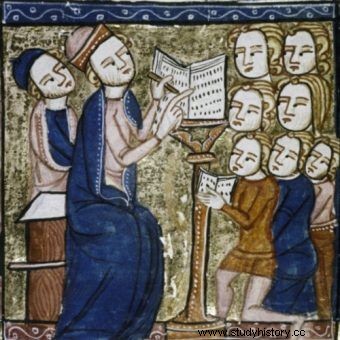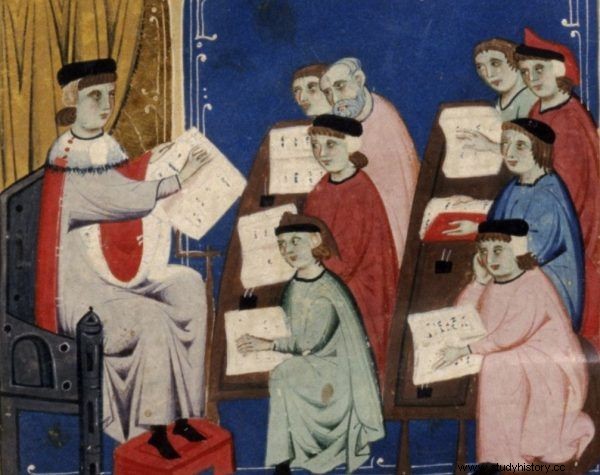There were no primary schools then, and the existence of cathedral schools cannot be confirmed. However, the rulers created their own private schools:outside, strictly for the needs of their daughters and sons. What could you learn there?
Education in the early Middle Ages was strictly based on the guidelines of the Fathers of the Church. Some of this advice was well over half a thousand years old, but no one was bothered by it. On the contrary, the older the instructions were, the more trustworthy they seemed. After all, they have been meticulously tested on hundreds of years. So what if in completely different conditions and a different culture ...

Teacher and students in a medieval school. English miniature from the 14th century.
One of the first and most influential Christian educators, Saint Jerome, recommended that both boys and girls should be educated in the same way and at the same age. Admittedly, he noted with skepticism that a child before the age of seven "does not understand what you say to him", but he ordered the children to be taught much earlier anyway.
Right age to learn
The seventh birthday was to be the border of systematic school education, but a completely unprepared child could not be sent to it. More than five hundred years later, in Poland and the Czech Republic, the approach was very similar. Before the son destined for a priestly career was sent to the bishop's court and the younger daughter to the monastery, they received the basic education in the father's house. Most often, the rest of the siblings were also taught:even if they were meant to have a purely secular life.

Medieval school on Italian miniature from the 14th century
A teacher could be one of the princely chaplains or even a tutor specially brought from abroad. And it was definitely not a one-on-one lesson. The pedagogical treatises clearly recommended that the activities be conducted in groups so that the children can learn from each other or compete in learning.
In the case of a makeshift school intended strictly for princely descendants, this meant that her sister Mlada and brother Strachkwas had to acquire knowledge together with the young Dobrawa. And together with the son of Bolesław the Brave, Mieszko II Lambert, an anonymous daughter, who would become the priest of the Benedictine nunnery in the future, also studied. And I don't think any of them had much fond memories of that stage of their lives.
Reading without understanding
The basis of education at the elementary level was not known from today's schools "reading comprehension", but its complete opposite. The children began their learning by reciting the psalter. The choice of this particular reading as a primer did not raise any doubts. Education was primarily to be a gateway to more efficient, though not necessarily more conscious, prayer. The beginning student was expected to be able to chant all the psalms from memory before even knowing the meaning of a single Latin word or learning anything about reading the letters of the alphabet.
It was a completely mindless science. Saint Jerome explained that a child should "love what he has to learn so that it is not a job for him, but a pleasure". However, let's face it. For Dobrawa, Mieszko II and every other child, education in a similar way was a real torture.
Letters from the bark and dead speech
Only at the next stage, were they taught to associate sounds and words with individual letters written in the book. The children were supported by letter models made of wood or bark. Similar teaching aids were used in medieval monastery or cathedral schools, so it was certain that ducal descendants could also demand access to them. But this in no way brought them closer to understanding what they were reading. The exclusive language of all texts was Latin - a dead speech that was not used by clergy and scholars on a daily basis and which will experience a kind of renaissance only in the following centuries.

The first Polish court school was probably established here:in the palas of Mieszko I in Ostrów Tumski. Visualization made by Piotr "Pitwala" Walichnowski.
You had to be fluent in thousands of words and in various ways of writing them, in order to even begin to understand the text of the psalter. What about any other book. Overcoming the language barrier was all the more difficult as there were no Latin textbooks or even real dictionaries. In Ars Minor , which is commonly used for this purpose Donatus, there was only one verb with conjugation and a small collection of nouns. There were also slightly more detailed publications, but their authors focused on abstract arguments about the nature of language rather than on practical explanations of grammar.
Trial and Error
For Czechs or Poles, the task was doubly troublesome, because no one really knew how to translate Latin into Slavic languages. Many words had to be created from scratch, others had to be combined or given new meanings. In the times of Bolesław the Brave (995-1025), this process was still ongoing, and in the times of Mieszko II (1025-1034) it was not finished at all.
The language of the Romans - and above all the language of the Vulgate - was transplanted to new ground by trial and error. The education of the princely offspring was probably the same. Only that when the distinguished children made mistakes, the teacher immediately whipped them with a stick. There were also no doubts about this pedagogical treatise.
The Middle Ages blindly believed that school must hurt. Vincent of Beauvais, who wrote in a little later time, but traditionally based on ancient patterns, even wrote about the "ultimate sweetness" brought about by corporal punishment. However, you cannot be sure if the students shared his enthusiasm.
Bibliography:
- J. Dowiat, The scholar circle and its institutions [in:] The culture of medieval Poland in the 10th – 13th centuries , ed. J. Dowiat, Warsaw 1985.
- J. Dowiat, Mental education of princes and magnates in Poland and some neighboring countries in the 10th – 12th centuries [in:] of the same, Poland in the world. Sketches from the history of Polish culture , Warsaw 1972.
- A. Fijałkowski, Puer eruditus. Educational ideas of Vincent of Beauvais (c. 1194–1264) , Warsaw 2001
- A. Kuźmiuk-Ciekanowska, Saint and history. The Přemyslid dynasty and its heroes in the work of monk Krystian , Krakow 2007
- H. Łowmiański, The beginnings of Poland , vol. 4, Warsaw 1970
- R. McKitterick, Kingdom of the Carolingians. 751-987 , Warsaw 2011
- K. Maćkowiak, The Beginnings of Polish Linguistic Awareness (X – XII Century) , "Polish language", vol. 86, no. 2 (2006)
- P.B. Newman, Growing Up in the Middle Ages , Jefferson 2007
- K. Ratajczak, Education of women in the Piast dynasty in the Middle Ages , Poznań 2005
- K. Stopka, Cathedral schools of the Gniezno metropolis in the Middle Ages , Krakow 1994
